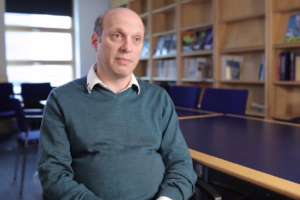Autophagy
Molecular Neurogeneticist David Rubinsztein on neurodegenerative diseases, stem cells, and fluorescent protein...
One of the questions about any type of gene regulation is to ask, whether or not it’s conserved. As Dobzhansky was saying — nothing in biology makes sense except in the light of evolution. So presumably, if something had been going on since our long gone ancestors, since tens, hundreds, billions years ago, then presumably there is some reason for that to happen. So it didn’t dissipate in all that time.
We found that in humans there is a large fraction of genes (between a few hundred to a few thousand) that can be expressed from one copy or from another copy (from one allele or another allele) but it’s not, or wasn’t completely clear whether or not it’s the same set of genes, that are in the mouse or not. Among other things, even apart from lofty evolutionary questions, if you know what’s going on in the mouse, it’s much easier to manipulate genetically — get tissues that you can’t easily get in humans, you could do transgenic mice, you could do all kinds of experimentation that is either impossible or very difficult if you’re working with human cells or tissues.
What we did, we took cloned cells from the mouse and these were specific mice? We crossed them. Mostly people work with different lines of mice, and what they want to do is to have inbred mice so there is as little variation between mice as possible. So they can have a colony and all of them are genetically identical. What we want is to separately measure the maternal copy and paternal copy and in order to do that we want to have differences between them and the differences are colloquially known as snips (SNP, which is a single-nucleotide polymorphism). We crossed one standard lab strain, 129, with the wild type strain called castaneus. On average what happens is that about every 124 bases there is a difference between these mice. Their progeny is perfectly fine, they have some trouble mating but they are happy mice. You can look at every tissue, and you can look at them and you can see what the difference is. Here is one gene, here is another gene, here there is a T, here there is a G and based on this snip you could measure relative levels of expression of a gene.
What we did then, we took B cells or, actually, pre-B cells and made clones of them. We place a single cell in a well, then it expands, cells divide, divide, divide and you have something like a 100 million cells. Then it turns out, if you take RNA from these guys and then you use a different technology that was developed for different purposes, so-called snip chips — they were developed to look at the genomic DNA, see what in the given position, what the nucleotide is.
For example, if you look at one parent, 129, it will be whatever it is, T here, if you look at another parent, it will be homozygous G in that position and, if you look at this F1 cross, then it will be a heterozygous TG. So you genotype father, you genotype mother and they’re homozygous for T, for G, and when you look at the F1 cross what you see is that it’s a heterozygous T and G — that’s what this technology is for. We sort of subverted it to measure what’s going on with the RNA or another cDNA and ask what would be the bias.
It turns out that, if you take clones from the same mouse or the same type of cells from individual mice, the differences are pretty big. If you take cells from females, one of these differences is that X-chromosome will chose one or the other direction to be inactivated but also in a lot of genes other chromosomes will chose to be expressed from this allele (from the maternal here, and the paternal over here) in a non-imprinted way. Some cells are choosing this, other cells from the same genotype, I mean, from the same individual are choosing something else.
One thing was that a fraction of genes was very similar to what was going on in humans, which is good, 10-15% of those genes we were able to measure, which is a couple of 1000 genes were expressed in this manner, sort of, autosomal analog of X-inactivation. We looked at the same cell type as we’ve previously done to humans. Very similar genes were affected. If you know what’s going on in a mouse, it’s very likely that the same gene is affected in people and vice versa. That also means that whatever is the mechanism that tells: this gene does this and this other gene never does something like this; this mechanism or whatever persisted since we and mice had a last common ancestor.
Another interesting thing that we didn’t expect was that there is another potentially deep analogy with X-chromosome inactivation. What happens usually is that about a half of the cells decide in one direction, a half of them decide another direction so, if you take the whole mouse, you put it in a blender and see what’s going on with expression, then both copies of the x are on — it’s just that each individual cell is 100% choosing one copy or 100% chooses the other copy and the other copy is completely silenced. But if you look, for example, at the same couple of mice, 129 and castaneus, when you look on average, what happens is that you have something like 80 20 sequence towards castaneus allele. It’s not because in each individual cell one allele is somewhat expressed while the other allele is expressed much more. What happens is, in each individual cell it’s still all or nothing but out of each hundred cells 80 cells would chose castaneus allele and 20 cells would chose 129 allele. Then everything goes on as it went before.
We see something quite similar when we look, for example, at ten individual clones, we do a transcriptome-wide analysis. What happens is that you see 8-9 clones have chosen one direction and 1-2 have chosen the other direction. And there are way more of the genes than we would expect by chance just from something there. It’s known, what the mechanisms are to pretty great detail. There is a genetic element on this chromosome called x-inactivation centre and depending on the precise sequence of it, it determines of the strength of the x-inactivation center. That’s why when you cross castaneous mice with 129 mice or other lab mice strains it’s the choice is more likely to occur in one direction than in other direction. Similar observation on the other cells leads us to a hypothesis that there is something very similar, a genetic element that controls this epigenetic switch early in the development, and that means that we should be able to narrow down and find it and live happily ever after.
Sort of a major problem that is there is what are potentially these regulatory elements. Presumably it’s some non-coding element, which we hypothesize for a number of reasons is probably fairly close to genes that are affected and that means that among other things we would be able to do a genetic manipulation of this. If we are unhappy about certain gene behaving in this manner, we would be able to, sort of, reset this and see what’s going on, but one thing that we need for this is a very high-density map — ideally a high-density map of this specific expression in various tissues.
There are major challenges there. One major challenge is that it’s very difficult to do. So this type of behavior is observable in clones but it’s very difficult to obtain clones from a lot of different tissues. Even more challenging is that often cloning is happening in culture, in cell culture, that is not an in vivo situation. Maybe we’re introducing artifacts by doing this. We think we now have solved this issue and we now can look at this but that’s subject for another story, which I’m not going to tell now.
There are definitely plenty of questions there but the availability of mice means that we can now do genetic manipulations, that we can now compare different strains of mice, and we can build these extremely high-density maps and see what’s going on, and all range of new technologies came in with the high-throughput sequencing, and we’re building tools to do that type of analysis, which will allow us to figure out what are the genetics of this epigenetic mechanism.
We found that in humans there is a large fraction of genes (between a few hundred to a few thousand) that can be expressed from one copy or from another copy (from one allele or another allele) but it’s not, or wasn’t completely clear whether or not it’s the same set of genes, that are in the mouse or not. Among other things, even apart from lofty evolutionary questions, if you know what’s going on in the mouse, it’s much easier to manipulate genetically — get tissues that you can’t easily get in humans, you could do transgenic mice, you could do all kinds of experimentation that is either impossible or very difficult if you’re working with human cells or tissues.
We took cloned cells from the mouse and these were specific mice? We crossed them. Mostly people work with different lines of mice, and what they want to do is to have inbred mice so there is as little variation between mice as possible. So they can have a colony and all of them are genetically identical. What we want is to separately measure the maternal copy and paternal copy and in order to do that we want to have differences between them and the differences are colloquially known as snips (SNP, which is a single-nucleotide polymorphism). We crossed one standard lab strain, 129, with the wild type strain called castaneus. On average what happens is that about every 124 bases there is a difference between these mice. Their progeny is perfectly fine, they have some trouble mating but they are happy mice. You can look at every tissue, and you can look at them and you can see what the difference is. Here is one gene, here is another gene, here there is a T, here there is a G and based on this snip you could measure relative levels of expression of a gene.
There are major challenges there. One major challenge is that it’s very difficult to do. So this type of behavior is observable in clones but it’s very difficult to obtain clones from a lot of different tissues. Even more challenging is that often cloning is happening in culture, in cell culture, that is not an in vivo situation. Maybe we’re introducing artifacts by doing this. We think we now have solved this issue and we now can look at this but that’s subject for another story, which I’m not going to tell now. There are definitely plenty of questions there but the availability of mice means that we can now do genetic manipulations, that we can now compare different strains of mice, and we can build these extremely high-density maps and see what’s going on, and all range of new technologies came in with the high-throughput sequencing, and we’re building tools to do that type of analysis, which will allow us to figure out what are the genetics of this epigenetic mechanism.

Molecular Neurogeneticist David Rubinsztein on neurodegenerative diseases, stem cells, and fluorescent protein...

How nanoparticles, bacteriophages, and agricultural regulation can help combat antibiotic resistance

New research provides more insights into dog-human communication